|
|
Advances in Phosphor-in-Glass for White LED
ZHANG Rui, Wang Bo-Yang, WANG Hai
2017 Vol. 32 (4): 337–345
 Abstract
Abstract(
2235 )
 HTML
HTML(
40)
 PDF
PDF(652KB)(
2436
)
Duo to the unique luminescent property, thermal conductivity and chemical stability, phosphors/glass composite (Phosphor-in-Glass, PiG) has a huge market application prospect as an alternative to silicon-based phosphor converter for conventional white LEDs, as well as a solution to the heat emission, luminous efficiency, quality, glare, lifetime and other technical problems at the same time. Herein, some key scientific topics in terms of PiG materials were analyzed, such as luminescence properties, transparency, mechanical strength, and mass production; the targeted optimization measures were also comprehensively summarized, including preparation methods (tabletting sintering, melt quenching, and film sintering), material composition design, and the structure optimization of phosphor layers. Generally, this review presents the most recent advances of excellent performance PiG materials, and also prospects their research trend.
|
|
|
Growth and Scintillation Properties of GdI3:Ce Crystal
YE Le, Shi Jian, Li Huan-Ying, Chen Xiao-Feng, Huang Yue-Feng, XU Jia-Yue, REN Guo-Hao
2017 Vol. 32 (4): 346–350
 Abstract
Abstract(
805 )
 HTML
HTML(
5)
 PDF
PDF(411KB)(
1183
)
Gadolinium iodide doped with Cerium (GdI3:2%Ce) and undoped gadolinium iodide (GdI3) crystals were grown by vertical Bridgman method with sealed quartz crucible. Crystal ingots with dimension of ϕ15 mm×20 mm were cut and polished to be plates of 12 mm×10 mm×2.5 mm and 11 mm×8 mm×2.5 mm. GdI3:2%Ce without crack and inclusion were encapsulated for all the measurements. X-ray diffraction analysis shows that the Ce3+-doped GdI3 and undoped GdI3 crystal have the same structure. X-ray and ultraviolet excited luminescence spectra of GdI3:2%Ce present broad emission bands peaking at 520 nm and 550 nm, respectively, which correspond to 5d-4f transition luminescence of Ce3+. Three peaks located at 262, 335 and 440 nm can be observed in excitation spectra when photoluminescence is monitored at 550 nm. The GdI3:2%Ce crystal presents an excellent energy resolution of 3.4% and decay time of (58±3) ns under excitation of 662 keV gamma-rays from 137Cs source. The results show the GdI3:2%Ce crystal is a promising scintillator for gamma ray and neutron detection.
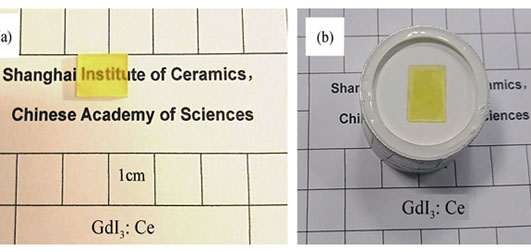
|
|
|
Synthesis and Catalytic Performances of SiC Nanoparticles by DC Arc-discharge Plasma
YU Jie-Yi, HUANG Hao, GAO Jian, ZHOU Lei, GAO Song, DONG Xing-Long, QUAN Xie
2017 Vol. 32 (4): 351–356
 Abstract
Abstract(
906 )
 HTML
HTML(
5)
 PDF
PDF(522KB)(
848
)
SiC nanoparticles were synthesized by direct current (DC) arc-discharge plasma method, using bulk Si as silicon source and in a mixed atmosphere of CH4, H2 and Ar. The chemical composition and morphology of the SiC nano product were affected by the pressure of CH4 obviusly. These products were characterized by Transmission electron microscopy (TEM), Raman spectra, Fourier transform infrared (FTIR) spectroscopy, X-ray diffraction (XRD), and X-ray photoelectron spectroscopy (XPS). The results indicate that the product contains the main phases of 3C- and 6H-SiC, while prepared at low CH4 pressure of 0.005 MPa, which exists few Si/SiC core-shell structures in the product. The SiC nanoparticles, prepared at 0.01 MPa CH4, were used as the catalyst to remove the Cl atoms in persistent 2,4-dichlorophenol through photoelectric catalytic reduction. The results show that the SiC nanoparticles have good photoelectric catalytic reductive dechlorination ability under ultraviolet illumination at a constant optical intensity of 500 mW/cm2. The removal efficiency reaches about 92.5% and the adsorption efficiency is 19.6% at an appropriate bias potential of -1.02 V after 180 min of photoelectric catalysis. Hence, SiC nanoparticles are identified as a kind of low-cost photoelectrocatalysis candidates to replace noble metals in wastewater treatments.
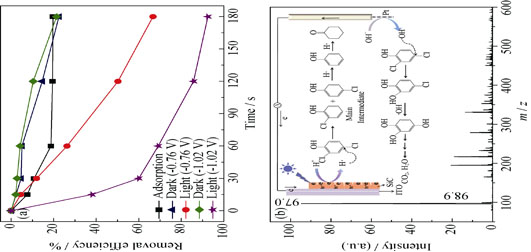
|
|
|
Preparation and Photocatalytic Properties of Mesoporous RGO/TiO2 Composites
LI Cui-Xia, JIN Hai-Ze, YANG Zhi-Zhong, YANG Xuan, DONG Qi-Zheng, LI Ting-Ting
2017 Vol. 32 (4): 357–364
 Abstract
Abstract(
997 )
 HTML
HTML(
15)
 PDF
PDF(599KB)(
1079
)
A series of mesoporous graphene oxide/TiO2 composites (GO/TiO2) with different mass fractions of graphene oxide (GO) were synthesized by an in-situ synthesized Sol-Gel step using GO, tetrabutyl titanate (TBT) as precursors, polyvinylpyrrolidone (PVP) as frame developing agent and citric acid as hydrolysis inhibitor and surfactant. Afterwards, mesoporous reduced graphene oxide/TiO2 (RGO/TiO2) composites were obtained by ultraviolet radiation reduction method. The composites were characterized by X-ray diffraction (XRD), Transmission electron microscopy (TEM), Brunauer-Emmett-Teller (BET), UV-visible diffuse reflectance spectroscope (UV-Vis DRS), and photoluminescence (PL) spectroscopy technology. The morphology and pore size distribution of RGO/TiO2 and the effects of RGO on the lifetime of photogenerated electron-hole pairs, adsorption capacity and photocatalytic activity of composite photocatalysts were investigated. The photocatalytic activity was evaluated under ultraviolet light and sunlight irradiation. Then the recovery test was studied under ultraviolet light irradiation. Results show that TiO2 nanoparticles are well dispersed on the surface of the RGO sheets and RGO/TiO2 composites are mesoporous materials. The introduction of RGO effectively inhibits the recombination of photogenerated electron-hole pairs and improves the adsorption capacity and photocatalytic activity of composites. The 7wt% RGO/TiO2 shows the best adsorption capacity for methyl orange. And 5wt% RGO/TiO2 shows the best and stable photocatalytic activity, after four recovery test, its photocatalytic degradation of methyl orange under ultraviolet light irradiation for 50 min exceeded 90% of the first test.
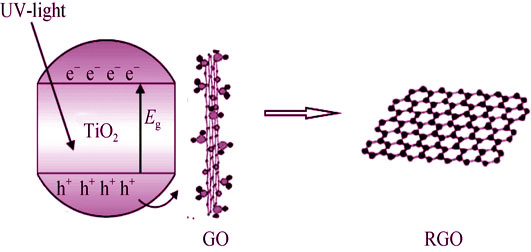
|
|
|
Preparation and Visible-light Photocatalytic Performance of Mesoporous Hollow TiO2/WO3 Spheres
YU Yang, TONG Ming-Xing, HE Yu-Lan, CHEN Hui, GAO Jing, LI Guo-Hua
2017 Vol. 32 (4): 365–371
 Abstract
Abstract(
980 )
 HTML
HTML(
13)
 PDF
PDF(770KB)(
1100
)
By using titanyl sulfate and ammonia metatungstate (AMT) as precursors and citric acid as a complexing agent, mesoporous hollow spheres of TiO2/WO3 composites were prepared via a two-step approach, which included a spray-drying process followed by a high-temperature calcination course. The morphologies, microstructures, surface area, crystal phase, and optical properties of the composites were characterized by SEM, TEM, BET, XRD and UV-Vis DRS. The results showed that the TiO2/WO3 composites were well-dispersed mesoporous hollow spheres with diameters around 1 μm, of which the wall consisted of nanoparticles and mesopores. What’s more, nanoparticles and mesopores increased with the calcination temperature. UV-Vis DRS analysis showed that the absorption spectra of TiO2/WO3 composites could extend from ultraviolet region to visible region, which was helpful to improve the utilization efficiency of sunlight. In addition, photocatalytic activities of the prepared samples were investigated by photo-degradation of methylene blue (MB). It’s found that the composite containing 3% molar ratio of WO3 with calcination temperature of 500oC showed the best photocatalytic activity. The degradation efficiency of MB with this composite could reach 99.1%, much higher than that of P25, which was only 29.5% under the same conditions.
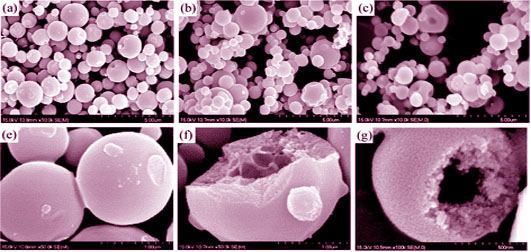
|
|
|
Capacitive Performance of Zn-Ni Hydroxide Nano-sheet Arrays on Nickel Foams via a Mild Chemical-bath Deposition Process
QI Xing-Yao, ZHOU Qing-Feng, CUI Mang-Wei, YANG Yong-Zhen, JIANG Hai-Wei, LIANG Wei, KANG Li-Tao
2017 Vol. 32 (4): 372–378
 Abstract
Abstract(
938 )
 HTML
HTML(
4)
 PDF
PDF(517KB)(
1103
)
Zn-Ni hydroxide nano-sheets were successfully deposited on nickel foams through a mild, cost-effective chemical bath method. SEM observation shows that these interconnected nano-sheets form a uniform marray layer and completely cover the surface of nickel foam. At the same time, additional homogeneously-precipitated hydroxide nano-sheets locate in the skeleton voids of nickel foams as aggregated porous clumps, resulting in a relatively high mass-loading of 4.27 mg/cm2. Afterwards, the electrochemical capacitive behaviors of this binder-free electrode were investigated by cyclic voltammetry, galvanostatic charge/discharge tests and electrochemical impedance spectroscopy. It is found that the Zn-Ni hydroxide electrode exhibits a specific capacitance of 746.2 F/g (areal capacitance of 3.18 F/cm2) at a current density of 1 A/g in 2 mol/L KOH electrolyte. Meanwhile, the Zn-Ni hydroxide electrode also shows a decent long-life cycling stability, retaining 70.9% of the initial capacitance after 3000 charge-discharge cycles.
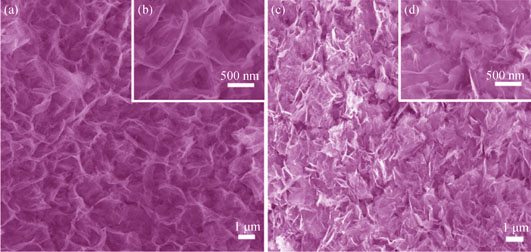
|
|
|
Preparation and Oxygen-reduction Mechanism Investigation of Nanostructure LSCF-SDC Composite Cathodes
XU Hong-Mei, ZHANG Hua, LI Heng, JIAN Yao-Yong, XIE Wu, WANG Yi-Ping, XU Ming-Ze
2017 Vol. 32 (4): 379–385
 Abstract
Abstract(
658 )
 HTML
HTML(
3)
 PDF
PDF(734KB)(
960
)
The solid oxide fuel cell nanometer composite cathodes were prepared by infiltration of La0.6Sr0.4Co0.8Fe0.2O3-δ(LSCF) precursor solution into porous Ce0.8Sm0.2O1.9(SDC) scaffolds followed by being calcined at 800℃for 4 h. The composition and the microstructure of the cathodes were analysed by X-ray diffraction (XRD) and scanning electron microscope (SEM). Average particle size of the LSCF phase is about 50 nm after being calcined at 800℃ for 4 h. The reduction reaction mechanism of O2 in the LSCF/SDC cathodes and the influence of LSCF loadings on the cathode properties were studied in terms of frequency response, electrode resistance and reaction order at different oxygen partial pressures p(O2). Three elementary steps are considered to be involved in the cathodes reaction: (1) absorption and dissociation of molecular O2; (2) oxygen ion conduction in the bulk cathode; (3) oxygen ion transfer at the cathode-electrolyte interface. The oxygen ion conduction in the bulk cathode is found to be the rate-determining steps in the nano-sized LSCF-SDC composite cathode. The reduction reaction mechanism of O2 in the cathodes is similar to the samples with different LSCF loadings. The polar resistance of the cathode firstly decreases and then increases with increasing the LSCF loadings. The cathode polar resistance reaches the lowest when the volume fraction of LSCF loadings is 16.5vol%.
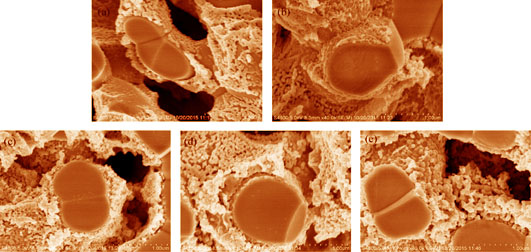
|
|
|
Preparation and Electrochemical Performance of Composite Electrode Material of Molecular Sieve Coated with Graphene
ZHAO Xiao-Chan, FANG Yan, FANG Chun-Hui, ZHOU Yong-Quan, GE Hai-Wen, ZHU Fa-Yan
2017 Vol. 32 (4): 386–392
 Abstract
Abstract(
638 )
 HTML
HTML(
2)
 PDF
PDF(831KB)(
1143
)
A 3D composite electrode was prepared by ultrasonic dispersion of a suspension mixed proportionally with 4A molecular sieve (4A) and graphene oxide gel (GO). The structure, morphology and electrochemical property of the 4A/reduced graphene oxide (RGO) composite were investigated by X-ray diffraction, Raman spectra, pore analysis, scanning electron microscope (SEM) and electrochemical measurements. The result shows that 4A is firmly adhered on the surface of RGO sheets, which can effectively avoid the stacking of RGO sheets. The RGO sheets link with each other to form a 3D electric conductive network in which can increase the electrical conductivity of the composite. The specific capacitance of 4A/RGO composite can reach 450 F/g at current density of 4 A/g when the mass ratio of graphene oxide and 4A is 1:6. Furthermore, the specific capacitance of 4A/RGO remains at 85.7% after 800 cycles under the same current density. Therefore these results indicate that this new composite possesses good rate capability and cycle stability and its supercapacitive performance is better than that of pure RGO or 4A. The excellent performance of the 4A/RGO composite can be attributed to the synergy between RGO and 4A.
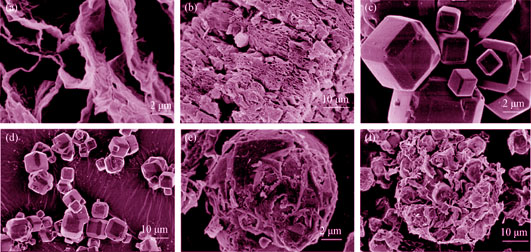
|
|
|
Fe-PPy-TsOH/C as Cathode Catalyst for Proton Exchange Membrane Fuel Cells
LI Shu-Ling, YUAN Xian-Xia, KONG Hai-Chuan, XU Jin, MA Zi-Feng
2017 Vol. 32 (4): 393–399
 Abstract
Abstract(
750 )
 HTML
HTML(
7)
 PDF
PDF(752KB)(
1374
)
Cathode catalyst is a dominant parameter hindering the development of proton exchange membrane fuel cells (PEMFCs), exploiting non-precious metal based catalysts with low cost and high activity has become an urgent task in recent decades. In this work, a non-precious metal based catalyst of heat-treated nitrogen doped carbon supported transition metal based catalyst (M-N/C catalyst) was chosen as the subject, and a series of Fe-PPy-TsOH/C catalysts were synthesized with iron salt as the metal precursor, BP 2000 carbon black as the carbon source, polypyrrole (PPy) as the nitrogen source, and methyl benzene sulfonic acid (TsOH) as the dopant. The effects of heat-treatment temperature and cobalt-doping on the phase structure, morphologyand catalytic performance towards oxygen reduction reaction (ORR) were comparatively investigated. It shows that 800℃ is the optimal heat-treatment temperature to prepare high performance Fe-PPy-TsOH/C catalyst. If the iron in the Fe-PPy-TsOH/C catalyst is replaced by appropriate amount of cobalt, its catalytic performance towards ORR could be further improved, and the best ORR performance could be achieved at a cobalt cotent of 33.33% (Fe:Co=2:1 in ratio) in the range of 0-50at%.
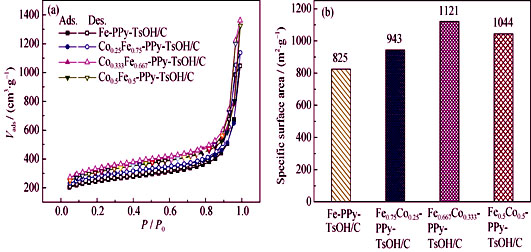
|
|
|
Thermal Stress Analysis of Solid Oxide Fuel Cell with Anode Functional Layer
XIE Jia-Miao, WANG Feng-Hui
2017 Vol. 32 (4): 400–406
 Abstract
Abstract(
720 )
 HTML
HTML(
5)
 PDF
PDF(551KB)(
1129
)
In order to reduce the thermal stress of solid oxide fuel cell in the process of preparation and working, and improve the electrochemical performance of the cell, the functionally graded layer is introduced into the cell. Due to the property of the functionally gradient material changes continuously or stepwise in a certain direction, the layer can reduce the difference of material parameters and relieve the thermal mismatch stress between layers effectively. On the basis of the previous research and the idea of hierarchical method, the anode functional layer is introduced into the solid oxide fuel cell, and the material parameters of the sub-layers are controlled through the anode functional layer number and the nonlinear gradient component exponent n. Thermal stress of the solid oxide fuel cell is studied at 800℃ within the operating temperature. The results show that the maximum tensile stress of the anode layer and the maximum compressive stress of the electrolyte layer decreases by introducing the anode functional layer. With the same anode functional layer number, the maximum tensile stress increases with the exponent n, and the maximum compressive stress of the electrolyte layer decreases with the exponent n increase. The thermal stress may lead to cracks and destroy the solid oxide fuel cell structure. This research provides theoretical basis for design and optimization of the solid oxide fuel cell.
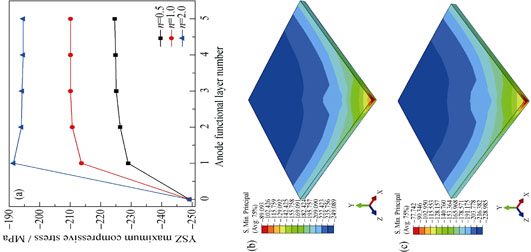
|
|
|
Reaction Synthesis and Discharge Performance of Binary Vanadium Borides
PAN Yu, LU Xin, WEI Zhi-Guo, WANG Guo-Qing, QU Xuan-Hui
2017 Vol. 32 (4): 407–412
 Abstract
Abstract(
567 )
 HTML
HTML(
2)
 PDF
PDF(529KB)(
1037
)
Vanadium boride compound powders with different compositions were prepared by reactive synthesis at 1500℃ from elemental powders. Then, with the obtained powders as active materials, Ni powder as conductive agent and NH4HCO3 as space-holder, the porous anodes of V-xB/Ni (x=2/3~2) were fabricated by powder metallurgy (PM), respectively. The effects of V-xB compounds with different phases on the discharge performance of the assembled air batteries were studied. The results show that the single-phased VB2 powder can be obtained from the raw powder with the atomic ratio of V:B=1:2, and so does the VB powder. As for atomic ratio of V:B=3:2, the synthesized powder consists of V3B2 and a small amount of VB, while the ratio of V:B=2:3 yields the phase composition of V2B3, V3B4 and minor VB2. The prepared V-xB/Ni anodes with porosity of 60.25%-61.75% exhibit good discharge performance, and their capacity can reach the range of 6129-7901 mAh while specific capacity is 2724-3511 mAh/g. With the increase of B content, the discharge performance of V-xB/Ni anodes shows a significant improvement. In comparison, the porous V-2B/Ni anode possesses the superior discharge properties with discharge capacity of 3512 mAh/g, coulombic efficiency of 86.5% and specific energy of 2504 Wh/kg.
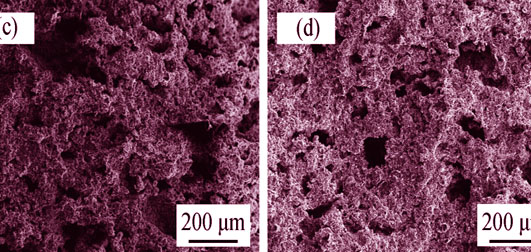
|
|
|
Properties of CdS:Al Films Deposited by Magnetron Sputtering
WANG Fo-Gen, CHEN Yun-Lu, REN Sheng-Qiang, ZHANG Jia-Yuan, WU Li-Li, FENG Liang-Huan
2017 Vol. 32 (4): 413–417
 Abstract
Abstract(
747 )
 HTML
HTML(
5)
 PDF
PDF(465KB)(
1017
)
CdS:Al thin films with different doping concentrations were deposited by controlling deposition rate of CdS and Al targets in co-sputtering process. The morphological, structural, optical, and electrical properties of as-prepared CdS:Al films were investigated by X-ray diffraction (XRD), atomic force microscope (AFM), UV-visible absorption spectrum, and room temperature Hall-system. XRD patterns indicates that all the CdS:Al films are polycrystalline films with hexagonal wurtzite structure and have a preferential orientation in (002) direction. The uniform and compact films can effectively be formed on insulating substrates. It is worth noting that the average grain size increases with Al doping concentration. On the other hand, the surface root-mean-square (RMS) roughness also shows slightly increase. UV-visible transmittance spectra show that the band gap of CdS:Al film decreases slightly in the range of 2.42-2.46 eV with increasing Al doping concentration. The Hall measurements indicate that the effect of Al doping concentration on electrical property of CdS films is apparent. In comparison with the un-doped CdS thin films, the carrier concentration of CdS:Al films increases by three orders of magnitude when the Al concentration is higher than 3.8%, while the resistivity of which decreases by three orders of magnitude. The doping level of CdS films is improved by doping with Al atoms to enhance the built-in electric field, which may realize high open voltage (Voc) for CdTe thin film solar cells. The properties of CdS:Al film prepared by co-sputtering are suitable as a window layer of CdTe thin film solar cells.
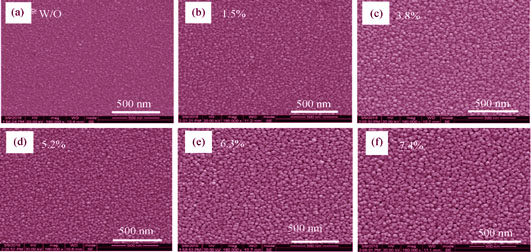
|
|
|
Electrolytic Composition on Wear Resistance and Corrosion Resistance of the Micro-arc Oxidation Coatings on TiCP/Ti6Al4V Composites
LUO Jun-Ming, WU Xiao-Hong, XU Ji-Lin
2017 Vol. 32 (4): 418–424
 Abstract
Abstract(
670 )
 HTML
HTML(
3)
 PDF
PDF(650KB)(
1495
)
The ceramic coatings were prepared by micro-arc oxidation (MAO) on the TiCP/Ti6Al4V composites. The effects of NaOH, C10H12CaNa2N2O8·4H2O and Na2SiO3 additives in NaAlO2 and NaH2PO2 solutions on the microstructure, corrosion resistance and wear resistance of the ceramic coatings were investigated, respectively. The results showed that coatings prepared in NaH2PO2 solution were composed of rutile and anatase TiO2, while coatings prepared in NaAlO2 solution consisted of Al2TiO5, γ-Al2O3, rutile and anatase TiO2. The NaOH addition could increase reaction rate of the micro-arc oxidtion, and the hardness of the MAO coatings could be enhanced by the addition of NaAlO2 and Na2SiO3. The thickness of the coatings formed in NaH2PO2 solution is 2-3 times thicker than that of the coating formed in NaAlO2 solution. The corrosion resistance of the coatings formed both in NaAlO2 and NaH2PO2 solutions, ranked from additives: Na2SiO3>C10H12CaNa2N2O8·4H2O>NaOH. Wear resistance of the coatings formed in the NaAlO2 solution ranked from the additives: Na2SiO3>NaOH>C10H12CaNa2N2O8·4H2O, while the wear resistance formed by NaH2PO2 solution ranked from additives: Na2SiO3>C10H12CaNa2N2O8·4H2O>NaOH. After micro-arc oxidation, all of the corrosion resistant and wear resistance of the MAO coatings were higher than those of the untreated TiCP /Ti6Al4Vcomposites. The mciro-arc oxidation coatings formed in NaH2PO2+Na2SiO3 solution showed the best corrosion resistance (about two orders of magnitude higher than that of the substrate) and better wear resistance.
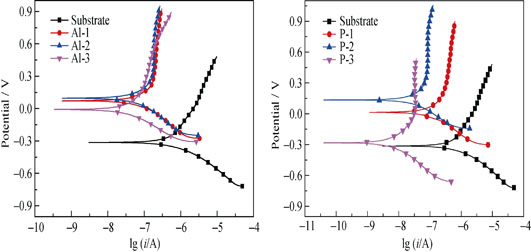
|
|
|
Multi-scale Simulation of Interpenetrating SiC/Al Composite Armor Materials Subjected to Impact Loading Using a Macro-micro Approach
LI Guo-Ju, FAN Qun-Bo, WANG Yang-Wei, SHI Ran
2017 Vol. 32 (4): 425–430
 Abstract
Abstract(
800 )
 HTML
HTML(
5)
 PDF
PDF(613KB)(
881
)
Since the macro anti-penetration performance of interpenetrating SiC/Al composite is controlled mainly by the complex three-dimensional microstructure features. Muti-scale simulation of SiC/Al composite under impact loading was performed by using a macro-micro method. The simulation for macro SiC/Al composite armor plate under impact loading was employed first, then the dynamic boundary conditions from the typical local regions in SiC/Al composite were obtained and applied on its microstructural finite element model as a loading condition to analyze the dynamic damage and failure process in the typical local regions. The results revealed that, in the local region right below the impact point, the cracks initiated mainly near the SiC/Al interface, just on the side of the SiC ceramic phase, then continuously propagated parallel to the direction of the bullet axis and eventually converged together to form axial main cracks. Meanwhile, in the region at a 45º angle to the direction of bullet axis, the cracks initiated not only near the SiC/Al interface but also inside the ceramic phase. Subsequently, these cracks propagated, bridged and finally formed cone main cracks. This simulation method provides a feasible technical approach for microstructure topology optimization of the material.
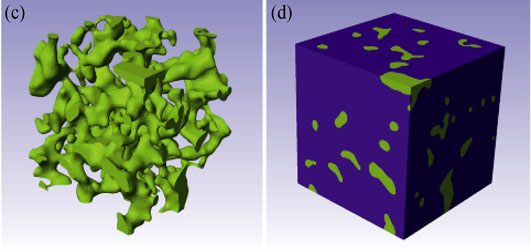
|
|
|
Low-temperature Preparation of Cu-containing Aluminum Phosphate Coatings on Stainless Steel and Antibacterial Properties
WANG Dong-Wei, DONG Ying-Hao, ZHOU Jie, DUAN Ke, LU Xiong, WANG Jian-Xin, FENG Bo, QU Shu-Xin, WENG Jie
2017 Vol. 32 (4): 431–436
 Abstract
Abstract(
621 )
 HTML
HTML(
1)
 PDF
PDF(468KB)(
1017
)
Aluminum phosphate coatings containing different levels of Cu2+ ions (Cu/Al molar ratio: 0.025, 0.05, 0.1) were prepared on 316-stainless steel based on the curing reaction of monoaluminium phosphate (MAP). The curing behaviors of the starting materials and phase compositions of the cured products were studied by differential scanning calorimetry and X-ray diffraction, respectively. Results indicate that the copper-free MAP cures at ≤250℃ to form 3 major phases: AlH2P3O10·2H2O, AlPO4, and Al8H12(P2O7)9. When Cu2+ ions are introduced into the MAP, an additional phase of Cu2P2O7 appears in the cured product. E. coli was inoculated on the surfaces of coatings to evaluate their antibacterial properties. After co-culture with E. Coli for 12 h, all Cu2+-containing coatings exhibit antibacterial effect and show a positive association between Cu2+ content and antibacterial activity. After co-culture for 24 h, no viable bacteria remain on any Cu2+-containing coating. The addition of ethylenediaminetetraacetic acid to the culture medium substantially inhibits the antibacterial activities of all coatings, confirming that the antibacterial effect is attributed to the release of Cu2+ ions from coatings. Pull-out tests show that the bonding strengths of the coatings range between 14.5-18.1 MPa. Potentiodyanmic polarization indicates that the coatings reduce the corrosion current density of the stainless steel substrate by approximately two orders of magnitude.
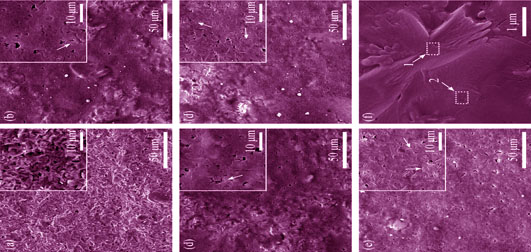
|
|
|
Terahertz and Metal-insulator Transition Properties of VO2 Film Grown on Sapphire Substrate with MBE
SUN Hong-Jun, WANG Min-Huan, BIAN Ji-Ming, MIAO Li-Hua, ZHANG Yu-Zhi, LUO Ying-Min
2017 Vol. 32 (4): 437–442
 Abstract
Abstract(
696 )
 HTML
HTML(
8)
 PDF
PDF(507KB)(
1087
)
High quality stoichiometric VO2 films were grown on single crystal sapphire substrates by molecular beam epitaxy (MBE), the film thicknesses were precisely controlled on the nanoscale ranging from 15 nm to 60 nm. For the optimized sample, a distinct reversible metal-insulator transition (MIT) with abrupt resistance change more than four orders of magnitude was observed, which was comparable to the ever reported result for high quality single crystal VO2. Especially, the optical properties in the terahertz (THz) frequency range were characterized with THz time-domain spectroscopy (THz-TDs) measurements for samples with various thicknesses, and the results indicate that the THz properties of VO2 film was significantly affected by the thickness. Therefore, the thickness should to be precisely controlled to obtain reproducible and reliable performance. The THz devices based on VO2 film may benefit significantly from these achievements.
|
|
|
Influence of N Doping on the Electronic Structure and Absorption Spectrum of Ca2SiO4: Eu2+ Phosphor
CHEN Hai-Tao, HUANG Xue-Fei, HUANG Wei-Gang
2017 Vol. 32 (4): 443–448
 Abstract
Abstract(
582 )
 HTML
HTML(
8)
 PDF
PDF(471KB)(
1009
)
The electronic structure and absorption spectrum of Ca2SiO4: Eu2+ was studied by using density functional theory. It is found that N atoms substituted provide many states around the Femi level, which leads to narrow optical band gap and interband transition originating from N2p to the Eu4f. In the N-doped Ca2SiO4: Eu2+ phosphor, Eu2+ ions experience a strong nephelauxetic effect and crystal field due to the coordinating nitrogen ions around the activated centers, which results in Eu4f and 5d states splitting. Thus, the red-shift of the absorption spectrum and high absorption band in the wavelength of 220-470 nm takes place for the N-doped Ca2SiO4: Eu2+ phosphor.
|
|